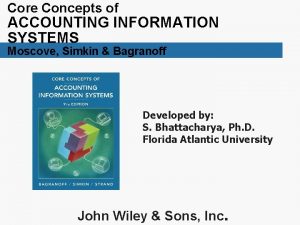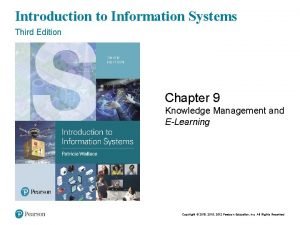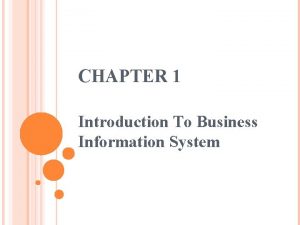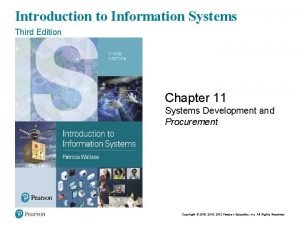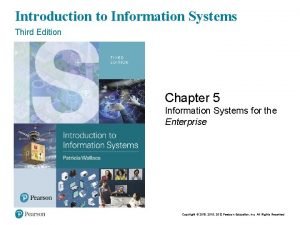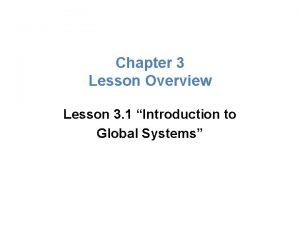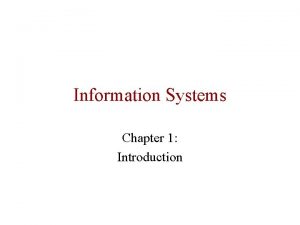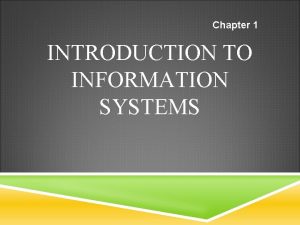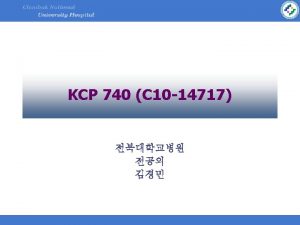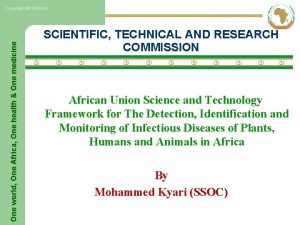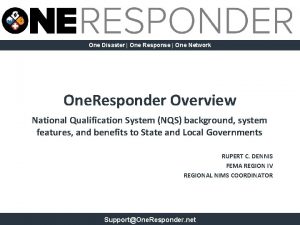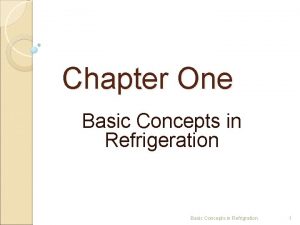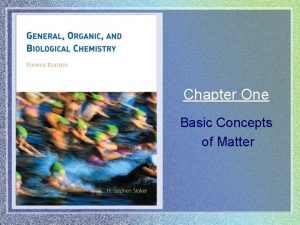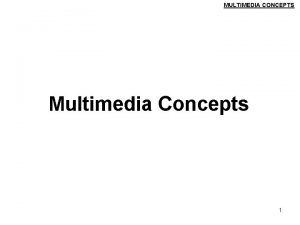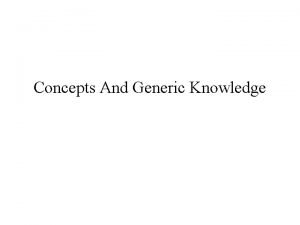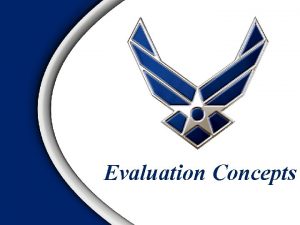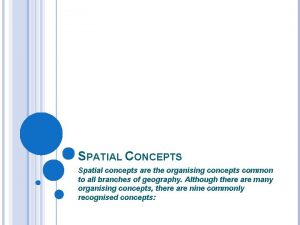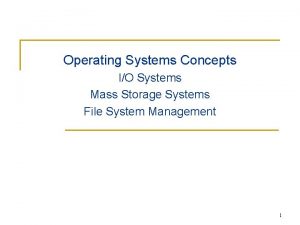Chapter One Introduction to Information Systems Information Concepts























- Slides: 23

Chapter One Introduction to Information Systems

Information Concepts The body of guidelines and procedures used to select, organize, and manipulate data to make it suitable for a specific task. Knowledge A collection of facts organized in such a way that they have additional value beyond the value of facts themselves. Information Raw facts Data Chapter One 2 IS for Management

Information Concepts Knowledge Base The collection of rules, procedures, and relationships that must be followed to achieve informational value or proper process outcome. Process A set of logically related tasks performed to achieve a defined outcome. Chapter One 3 IS for Management

Types of Data (Table 1. 1) Data Represented by Alphanumeric Numbers, letters, & other characters Image Graphic images or pictures Audio Sound, noise, or tones Video Moving images or pictures Chapter One 4 IS for Management

Characteristics of Valuable Information (Table 1. 2) 4 4 4 Accurate Complete Economical Flexible Reliable Relevant Chapter One 4 4 4 5 Simply Timely Verifiable Accessible Secure IS for Management

The Value of Information (Figure 1. 2) Chapter One 6 IS for Management

Components of a system INPUTS Gathering and capturing raw data PROCESSING Converting or transforming data into useful outputs OUTPUTS Producing useful information, usually in the form of documents. Feedback Output that is used to make changes to input or processing activities Chapter One 7 IS for Management

System Classifications & Primary Characteristics Simple Complex Open Closed Stable Dynamic Adaptive Non-adaptive Permanent Chapter One Temporary 8 IS for Management

System Performance Standards 4 Efficiency A measure of what is produced divided by what is consumed. 4 Effectiveness A measure of the extent to which a system achieves its goals. 4 Performance Standard A specific objective of the system. 4 Superior - Standard - Deficient • Sales performance • Market share • Defective parts experience • Scrap output rate Chapter One 9 IS for Management

System Variables & Parameters 4 System Variable A quantity or item that can be controlled by the decision maker. 4 System Parameter A value or quantity that cannot be controlled by the decision maker. Chapter One 10 IS for Management

Modeling a System 4 Model An abstraction or an approximation that is used to represent reality 4 Model Types • Narrative: • Physical: • Schematic: • Mathematical: Chapter One Words Tangible Graphical Formula 11 IS for Management

Information System (IS) A set of interrelated elements or components that collect (input), manipulate (process), and disseminate (output) data and information and provide a feedback mechanism to meet an objective. Chapter One 12 IS for Management

Computer-Based Information Systems (CBIS) 4 Computer-Based Information Systems Composed of hardware, software, databases, telecommunications, people, and procedures that are configured to collect, manipulate, store, and process data into information. 4 Technology Infrastructure The shared IS resources that form the foundation for the information systems. 4 Business Information Systems Transaction: Any business related exchange. Chapter One 13 IS for Management

Types of CBIS (1) 4 Transaction processing system An organized collection of people, procedures, software, databases, and devices used to record completed business transactions. 4 E-Commerce Any business transaction executed electronically between parties involving the exchange of goods and/or services for an equitable consideration. 4 Management Information System Organized set of people, procedures, databases, and devices used to provide routine information to managers and decision makers. Chapter One 14 IS for Management

Types of CBIS (2) 4 Decision Support Systems A set of people, procedures, databases, and devices used to support problem-specific decision making. 4 Artificial Intelligence (AI) A group of types of CBIS that involve computer systems taking on the characteristics of human intelligence • Expert Systems (ES) • A set of people, procedures, databases, and devices used to give the computer the ability to make suggestions and act like an expert in a particular field • Robotics • Natural Language • Neural Networks, etc. Chapter One 15 IS for Management

Systems Development The activity of creating or modifying business systems. Investigation Analysis Design Implementation Review Chapter One 16 IS for Management

Project Management A method and set of techniques based on accepted principles of management used for planning, estimating, and controlling work activities to reach a desired end result – on time – within budget – according to specification. Chapter One 17 IS for Management

International IS International Arenas – – Cultural specific consumer needs Dynamic economies, statutes, business practices Pace of change leads to a moving target market Differences in technology available Chapter One 18 IS for Management

IS Strategy 4 Achieving effective regionalisation to meet market demographics requires an effective IS infrastructure 4 IT professionals are business model enablers 4 Know your mission statement Chapter One 19 IS for Management

Literacy 4 Computer Literacy A knowledge of computer systems and equipment and the ways they function. 4 Information Systems Literacy A knowledge of how data and information are used by individuals, groups, and organizations. Chapter One 20 IS for Management

Management’s IT challenge 4 Strategic IT – How can IT be used to design a competitive and effective organization? 4 Investing in IT – How do you determine value of IT for the organization? 4 IT architecture – How can the organization design IT that fits? 4 Global IT – How can IT help guide an organization globally? 4 Ethics of IT – How can we ensure an organization will use IT in a socially responsible manner? Chapter One 21 IS for Management

Chapter One Cases for Discussion 4 Sales force automation (page 37) • Project issues 4 Liz Claiborne (page 38) • Challenges in strategic use and investment in IT Chapter One 22 IS for Management

Next class 4 Assignment #1: Part 1 4 Tutorial: Internet searching Chapter One 23 IS for Management
 Core concepts of accounting information systems
Core concepts of accounting information systems Physics chapter 1 introduction and mathematical concepts
Physics chapter 1 introduction and mathematical concepts Introduction to information systems 6th edition
Introduction to information systems 6th edition Introduction to information systems 6th edition
Introduction to information systems 6th edition Introduction to information systems 3rd edition
Introduction to information systems 3rd edition Introduction to information systems 5th edition
Introduction to information systems 5th edition Components of information systems
Components of information systems Introduction to accounting information systems
Introduction to accounting information systems Introduction to information systems 3rd edition
Introduction to information systems 3rd edition Introduction to information systems 3rd edition
Introduction to information systems 3rd edition One empire one god one emperor
One empire one god one emperor Little dog run
Little dog run One king one law one faith
One king one law one faith Byzantine definition
Byzantine definition One ford behaviors
One ford behaviors See one do one teach one
See one do one teach one See one, do one, teach one
See one, do one, teach one Night structure
Night structure See one do one teach one
See one do one teach one One vision one identity one community
One vision one identity one community One vision one identity one community
One vision one identity one community Relational database management system concepts
Relational database management system concepts Operating systems concepts
Operating systems concepts Levels of ecological organization
Levels of ecological organization
